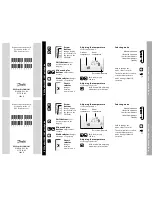
UMAX180800, 20 Thermocouple, 2 RTD, 4 Inputs, 6 Relays Dual CAN Controller
Version 1
Page: 15-71
The Modbus interface is presented by the
Ethernet
function block that contains Modbus
TCP/IP network settings.
For data processing, when required, there are
Math, Set-Reset Latch, Lookup Table
Conditional Logic, and Programmable Logic
function blocks. They perform a unique set of
functions that is explained in respective part of the Section 3.
The converter also has a
Global Parameters
function block containing four constant output
signals and other auxiliary outputs.
3.1 Function Block Signals
The controller function blocks can communicate with each other through internal signal inputs
and outputs. Each signal input of one function block can be connected to any signal output of
another function block using an appropriate configuration parameter. There is no limitation on
the number of signal inputs connected to one signal output.
When a signal input is connected to a signal output, data from the signal output of one function
block is available on the signal input of another function block.
Function block signals
can be “Undefined”, “Discrete” or “Continuous”. The “Undefined” signal
type is reserved for a disconnected signal source or a no-signal transient condition. The
“Discrete” and “Continuous” signal types are used to communicate discrete and continuous
signals, respectively.
Discrete signals present data with a finite number of states. They are stored in four-byte
unsigned integer variables
that can present any state in the 0…0xFFFFFFFF range.
Continuous signals present continuous data, usually physical parameters. They are stored in
single-precision floating-point variables. The continuous signals are not normalized and usually
present data in physical units.
When a discrete signal output is connected to a continuous signal input, the discrete signal is
converted into a positive continuous signal of the same value.
When a continuous signal output is connected to a discrete signal input, the following rules
apply. A positive continuous signal is converted into the same value discrete signal. A
fractional part of the continuous signal is truncated. If the continuous signal is above the
maximum discrete signal value, it is saturated to the maximum discrete signal value:
0xFFFFFFFF. All negative continuous signals are converted into zeros.
The undefined signals are converted into zeros unless the function block can process the
undefined signal state, for example:
CAN Output Message
function block will output all ones
for undefined signals.
3.2 Output Signal Sources
The controller output signal sources of all function blocks and source numbers are presented
in the table below.
















































